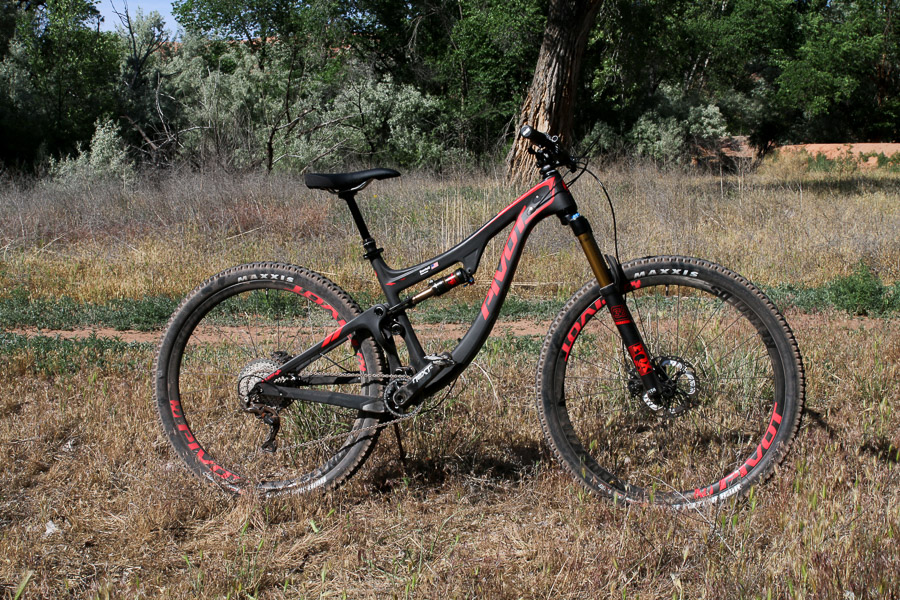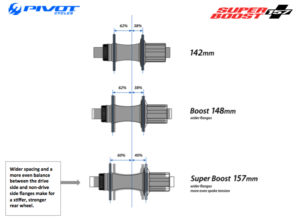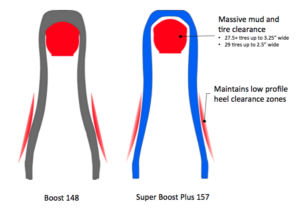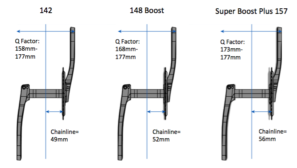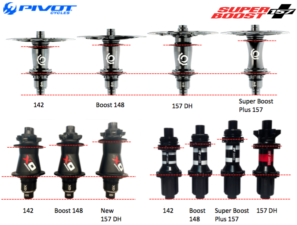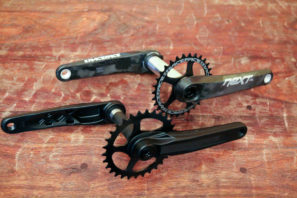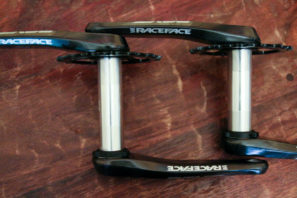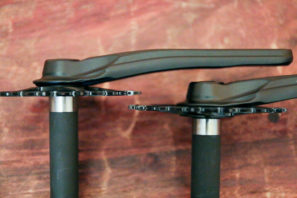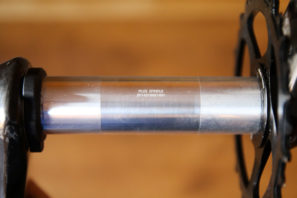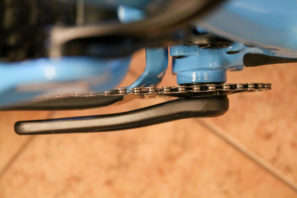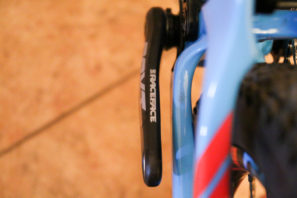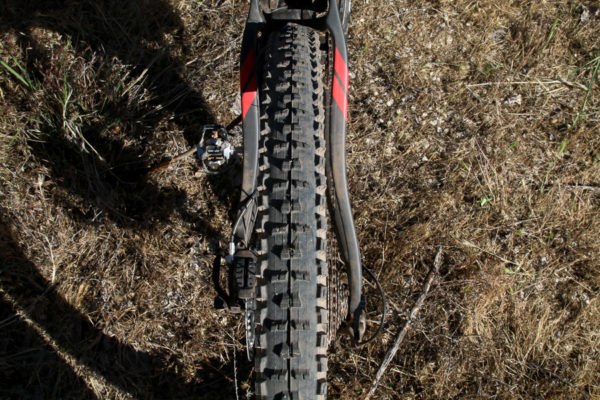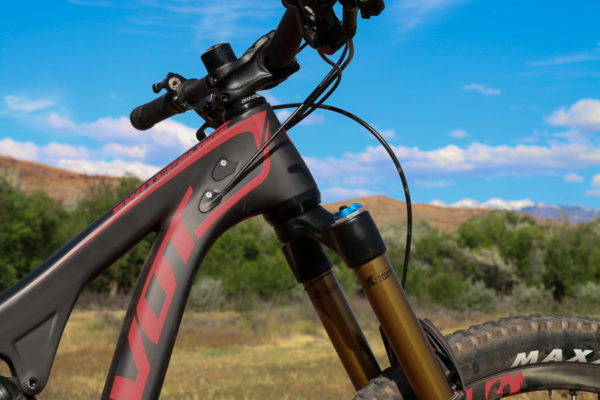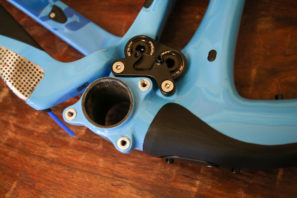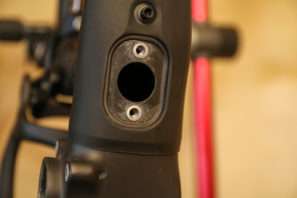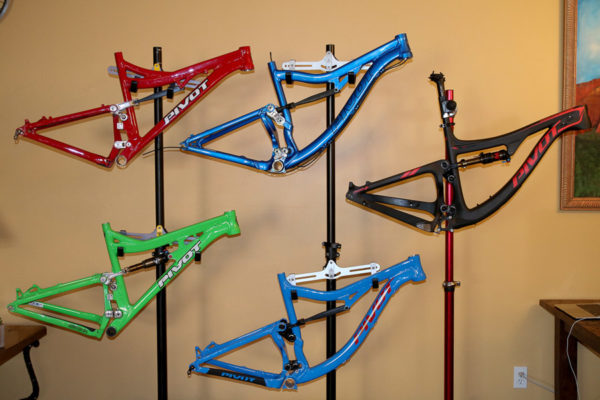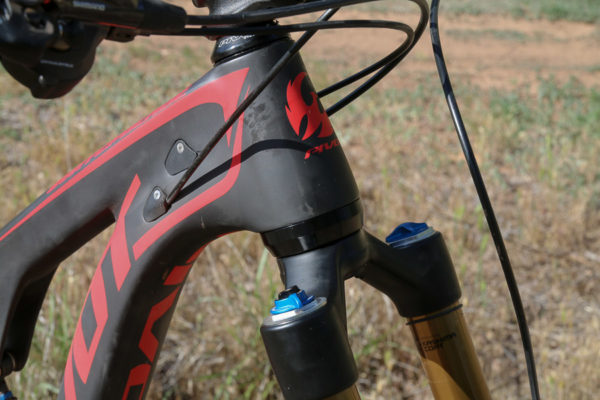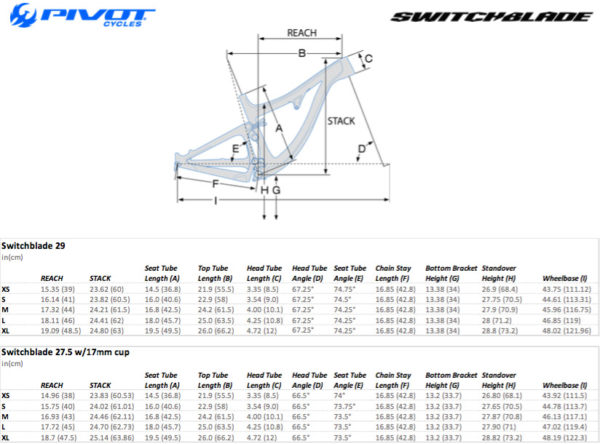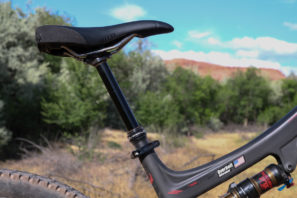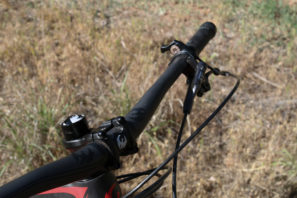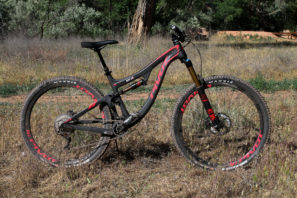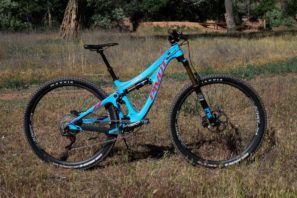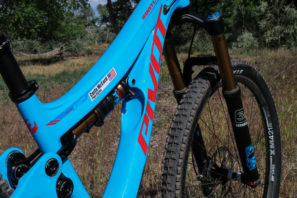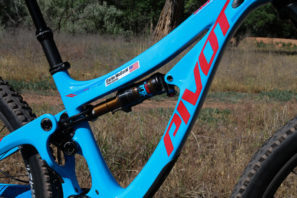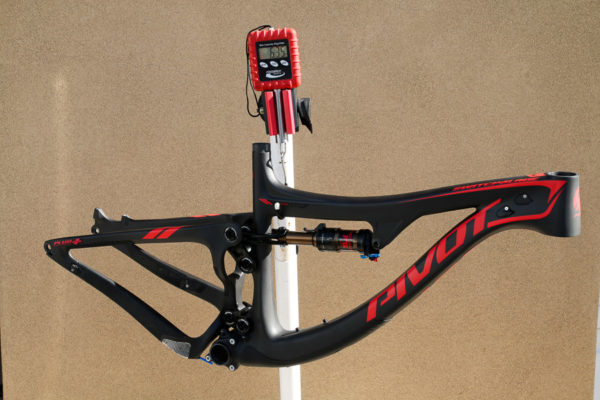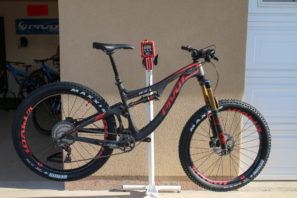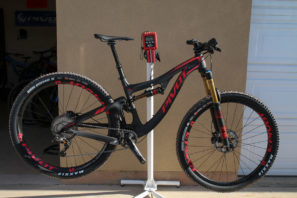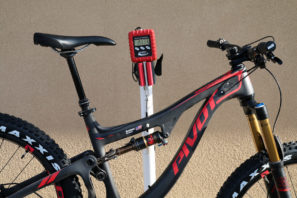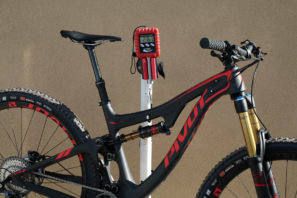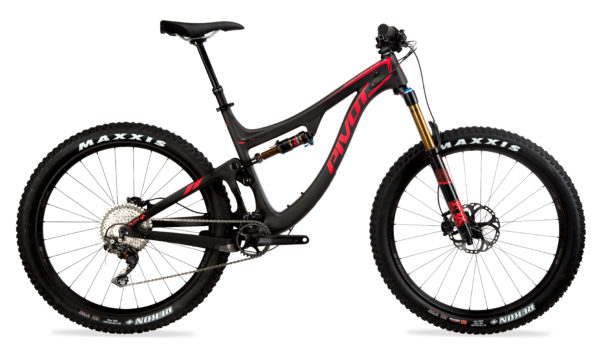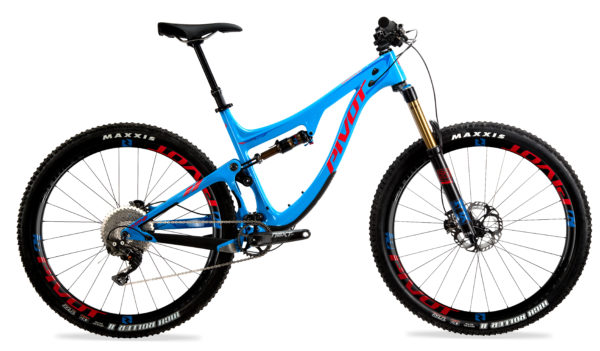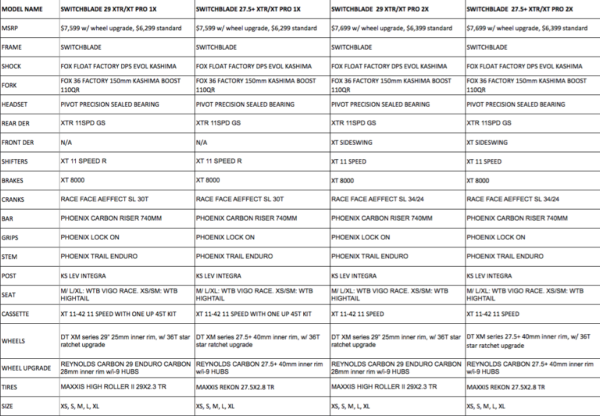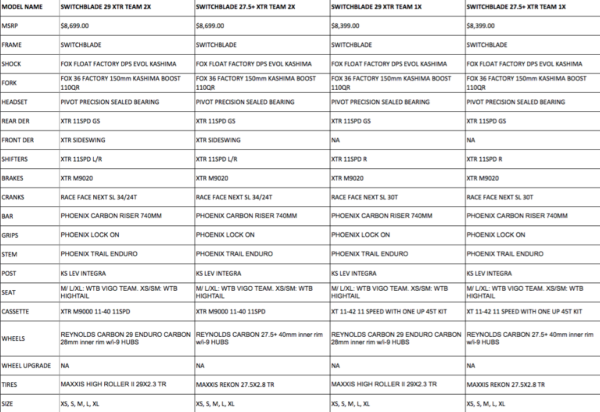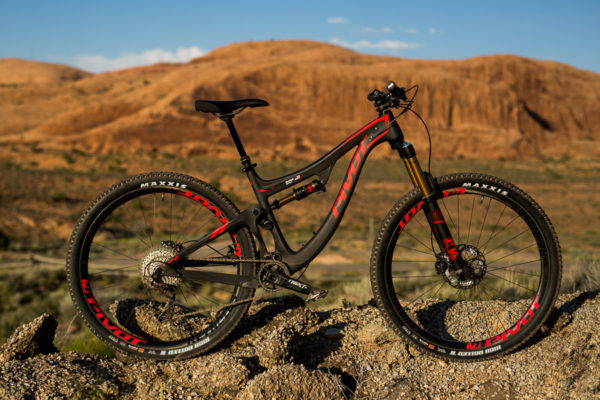
Since launching the brand in 2007, Pivot has added a lot of different models to the line up. Ranging from 26 to 29, even to fat bikes, Pivot has had a bike for just about anything – with one exception. While Pivot has offered a number of bikes with 29″ wheels, a “long travel” 29er has remained absent from the collection, though not because they haven’t been working on it. For the past 5 years Pivot has been quietly working on developing the perfect platform to match the big wheels with bigger travel. With each step the bike has gotten closer to perfection, but to make that last leap Pivot needed something new. Something that would provide the stiffness and the clearance for both 29 and 27+ tires. Something… like a wider rear hub.
“Don’t call it a ‘new standard.'” That was one of the points that Chris Cocalis tried to drive home as he introduced Pivot’s latest bike, the Switchblade. As you can imagine, the use of a different (yet currently existing) hub spacing will most likely draw ire from those already wary of Boost 148, but before heading to the comment section, you have to hear them out.
To Pivot’s credit, before they had even introduced the Mach 429 Trail with Boost 148 spacing, we had already had conversations with Cocalis about the limitations of Boost. As Pivot’s engineer Kevin Tisue put it, “WTF? Only another 3mm of chainline clearance?” Pivot was quick to point out that the 3mm did help to make the Mach 6 and 429 Trail a better bike, but they almost instantly used up all 3mm of additional clearance. In order to make a better long travel 29er and make it compatible with 27+, they were going to need more.
That’s where the cheekily named Super Boost + comes in. The name may sound like yet another standard, but in reality it is a combination of existing standards which have been optimized for maximum tire clearance, drivetrain compatibility, and frame stiffness. All of which make the new Switchblade an incredible machine…
For obvious reasons, Cocalis didn’t want Super Boost + to be the focal point of the bike, but I feel like it’s something that should be addressed right away, especially since it’s sure to be one of the more talked about features of the frame. True to Pivot’s words, this is not a new standard. By utilizing a 12 x 157 rear hub, the Switchblade is compatible with almost every DH hub that has been on the market since downhill bikes moved from the 150mm rear end. While those same hubs will fit in the new Switchblade, Pivot saw the opportunity to further refine the hub construction by widening the flanges (up to 14mm) to offer more even spoke tension (closer to 60/40) and a stiffer rear wheel. This thought was echoed by both DT Swiss and SRAM as each company had already planned to increase the flange spacing on their 157mm hubs before hearing about Super Boost +, which Cocalis mentioned that he felt validated the concept since both companies came to the same conclusion independently.
Pivot points out that the goal is not to replace Boost 148 spacing on XC/Trail bikes, but to provide a frame platform that is stiff enough for longer travel bikes with bigger wheels. In Cocalis’ opinion, 29″ wheels still haven’t been stiff enough for large riders which becomes more of an issue on longer travel platforms. To him, the addition of Super Boost + brings the stiffness of a 29″ wheel back to zero, or where we were with most 26″ wheels. It is possible however to be too stiff which is why wider hub sizes weren’t really needed on 26″ bikes.
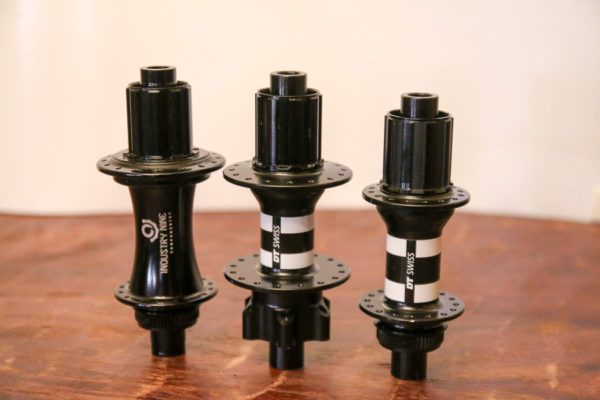
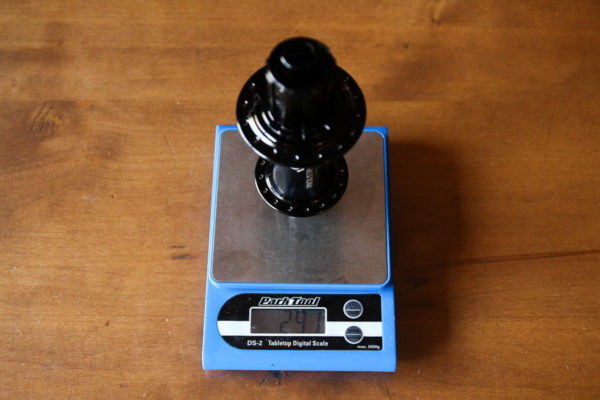
That in and of itself is a big motivator for the new bike’s design. Ever since we got away from the trusty 26″, bigger wheels have suffered in the stiffness department. Add in the need for huge tire and mud clearance with Plus size, and Super Boost + starts to make a lot of sense. And about the name – it originally started somewhat as a joke internally, but it ended up sticking. Pivot’s own FAQ section for the bike even points out that Super Boost + will make you a better person. Clearly, they’re not taking things too seriously when it comes to the name.
Pivot knows that the decision to use an even wider hub may make some riders unhappy, but it was something that had to be done to make this bike. Instead of 3mm of chainline clearance and 6mm of additional tire clearance, Super Boost + affords 6mm of chainline clearance and up to 12mm more room for tires.
For the initial launch, the Pivots were equipped with Reynolds wheels which use a custom hub from Industry Nine with an increased flange spacing. Consequently, SRAM and DT Swiss will also have hubs that follow the same thought process with wider flange spacing to get the most out of the hub design. As far as replacement wheels, at this point SRAM should have their new XO hub available soon which has similar dimensions to Super Boost +, while DT Swiss and Industry Nine/Reynolds have their own hubs, though availability is TBD. There is nothing wrong with running 157 x 12mm DH hubs, other than the wheel build won’t be as strong as those with an optimized flange spacing for Super Boost +.
More importantly, Pivot has been able to make the new rear triangle better in almost every way. It has more heel clearance than their Mach 4, offers monster tire clearance, swallowing up to 27 x 3.5 and 29 x 2.4 with plenty of room for mud, allows for super short 16.85″ chain stays, and it still uses mostly standard cranks with the same Q-factor as Boost 148.
The bottom bracket itself is a completely standard PF92 shell which will work with any PF92 BB on the market. For cranksets there are two options: some cranks like the RaceFace Aeffect Cinch use the standard 73mm BSA spindle but must use a chainring that can be flipped to get the proper chainline which has been a common practice with many fat bikes running narrower Q-factor cranks on bikes with 5″ tires. Other cranks like the new RaceFace Next SL G4 will need a special spindle that allows the arms to clear the stays, but won’t need a special chainring. These Plus Spindles will be a standard part number from RaceFace and thanks to the Cinch system, are interchangeable with any Cinch crank.
You can also run current DH cranks with spacers, though it will increase the Q-Factor. Currently the various cranks result in a 173-177mm Q-factor, but Pivot says there will be cranks available in the future that will make a 168mm Q-factor a possibility. The short of it is that even with the wider hub spacing and wider chainline, Pivot was able to maintain all of the important ergonomics to make the Switchblade pedal just as well as any Boost 148 bike, but with a lot more tire clearance and stiffness.
It also keeps the ability to run a front derailleur which still accounts for 40% of Pivot’s builds. Combined with the Pivot Cable Port system, the Switchblade can run any drivetrain, mechanical or electronic and has easily accessible ports for convenient internal routing of all cables and wires. There is even clearance for up to a 36t single chainring which is good news for those running the new ultra wide range cassettes. Better still, the chainline has been improved for use with 1x drivetrains to allow better access to the lower gears for less stress on the chain. The only draw back (if you could call it that) to the wider hub is that you can’t run a 200mm rotor out back. There probably aren’t that many riders who really need a 200mm rotor on the rear of their enduro bike, so Pivot felt this was an acceptable compromise.
It’s probably important to mention that this isn’t a proprietary technology. Pivot says any company is free to use the “open non-standard” and is already aware of at least one brand who is currently using 157mm hubs on their bikes. Again, Pivot is not trying to replace boost, as Super Boost + isn’t ideal for XC race bikes, but sees 148 and 157 becoming our two common “standards” – even though Cocalis hates the use of the word.
Cocalis states, “Whenever we run into something that prevents us from improving a bike or taking it to the next level, we will investigate any and all ways and technologies that could be used to improve it.” When asked if we would see even wider hubs in the future, Cocalis said it would be unlikely. This is sort of the limit when it comes to Q-factor and heel clearance, but that limit wasn’t reached with Boost 148. It was obvious that Cocalis felt that 157 was probably the way to go from the beginning, but with bigger companies pushing Boost 148, they didn’t have much choice. He still feels that 148 will be useful for XC and Trail bikes, but for long travel and Plus applications, Super Boost + is the answer.
Because of that answer, Pivot was finally able to create the long travel 29er that they had been perfecting for the past 5 years. On the first generation prototype (above, red), Pivot started experimenting with their clevis suspension linkage and an eccentric pivot. At the time there was a single upright on the rear triangle thanks to limited clearance around front derailleurs with non-boost spacing and narrower rims and tires.
Generation 2 in green saw bigger bolts and beefed up suspension linkage, but the frame was still too flexy. This did lead to the creation of the first generation Mach 6, but the long travel 29 project ended up on the back burner for a while.
Generation 3 (top, blue) is the version where things really started to take shape about 1-2 years ago. Suspension linkage similar to the Phoenix DH bike was used, the dual upright rear triangle was introduced thanks to the addition of the Shimano Sidewing front derailleur, and the stiffness levels were getting closer to the goal. From here it was mostly a geometry project to try and dial in all of the clearances, ergonomics, and frame shapes which led to Gen 4 (blue, bottom).
It was here that Super Boost + finally made an appearance, the geometry and suspension rates were all dialed in, and Pivot started playing with Plus tires which led to experiments in tire size and BB height. It’s probably no coincidence that much of their testing took place in Moab which is exactly where Pivot invited us to in order to check out the new bike. After the final prototype frames were turned out from their in-house aluminum prototyping facility, Pivot tooled up for carbon production to create the final bikes. Apparently they are working on an aluminum version, but it’s harder to create the stiffness levels and clearances for the new frame in aluminum so it will be a bit before we see it.
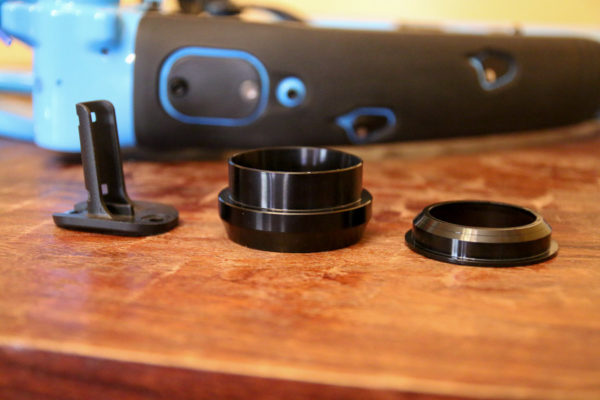
The addition of Plus tire compatibility also adds an interesting dimension to the story. Initially on the Mach 429 Trail, Pivot built the frame to accept the wider tires but without any special concessions as far as the frame’s geometry. It still rides very well in Plus mode, but customers started to point out that they felt the bottom bracket was a bit low thanks to the slightly smaller size of the 27 x 2.8″ tires. The trick with plus tires is that their overall diameter varies greatly with rim and tire size so the Switchblade includes a special adapter to alter the geometry for Plus size tires.
Pivot was already making an extended lower headset cup on the Les Fat, so the concept was simply adapted to the geometry of the Switchblade. After a few different prototypes, Pivot settled on a 17mm lower headset cup that raises the bottom bracket and maintains the geometry within 1/2º at the head tube and seat tube. The bottom bracket height varies by only 0.3cm, while wheelbase and standover maintain similar measurements as well. Each bike will include both headset cups (Zero stack and the 17mm) which use the same lower bearing. Both the 29″ and the 27.5+ builds will have the 17mm cup already installed so that when dealers cut the steerer tube there will be enough length for the longer head tube. Without the 17mm cup the head tube is as short as it can possibly be (on the XS) without running into the taper on the steerer tube which allows riders to get the bars as low as possible.
Geometry is another important detail to the Switchblade with Pivot implementing their new long and low geometry which is much more in line with current industry trends. Across the board, all sizes from XS to XL see quite a bit longer reach measurements which will be how Pivot sizes their bikes from here forward.
Equally important are the low standover heights and the ability to run longer dropper posts for all sizes. I ended up on a medium and was surprised to have the ability to run a full 150mm dropper post which rarely happens for my fit. Impressively, the chain stays on the Switchblade measure 16.85″ (428mm) which makes them shorter than the Mach 6, but also shorter than every other bike in the category. With the Plus tires or even bigger 29″ tires, this results in a bike that is a lot more agile and easier to manual or pull up off drops.
For those that know Cocalis’ stance on 29ers for smaller riders, the addition of that XS frame size may come as a surprise. Admittedly, Cocalis says, “in the past, I’ve dug my heels in that really small riders shouldn’t be on 29ers due to issues with proper design.” However, thanks to the longer reach and a number of clever frame tweaks, Pivot was able to offer an XS frame (above in blue) without any compromises. It was important to not exclude any riders from the Switchblade due to the advantages that 27+ wheels can provide to beginner and intermediate riders.
While the longer reach measurements allow the creation of a frame without any toe overlap, moving the shock mount to the downtube, eliminating the bottle cage inside the frame (all other sizes have a cage mount inside and will fit a large bottle by flipping the shock so the lever is facing up), and sculpting the top tube around the rear shock allows for a standover height similar to the Mach 4 XS while still providing room for a 100mm dropper post. The XS and S frames do include the WTB Hightail saddle which is needed for rear tire clearance if the seatpost is slammed. Otherwise, any saddle can be used.
That saddle clearance comes in handy when the 135mm of DW Link rear travel is fully compressed with big tires. Meant to be paired with 150-160mm suspension forks, all of the bikes ship with a 150mm travel fork which can be slacked out a bit in 29″ mode if you choose to run the 17mm lower headset cup as well.
Using the same Hollow Core internal molding carbon technology as their other frames, in spite of the massive rear end, the Switchblade comes in at 6.4lbs (2900g) for the frame and rear shock (without the rear axle and headset cups). Complete with a Pro 1x build, that comes out to a very respectable 27.71 lbs (12.57kg) for a medium bike in Plus configuration, and 27.67 lbs (12.55kg) for a small bike in 29er configuration. Interestingly, the Reynolds carbon wheels with a 40mm internal rim and Maxxis 27 x 2.8″ Rekon tires are actually about a 1/4 lb lighter than the Reynolds carbon 29er wheels with 28mm internal width and Maxxis 29 x 2.3″ HighRoller IIs (the difference in weight above is in the frame, saddle, and dropper).
Additional frame details include new ‘Ultra Quiet’ low durometer rubber integrated frame protection on the downtube, stays, and upright, a co-molded chain suck plate, ISCG 05 tabs (that will need an adapter ring from MRP to space out the guide), and the option for a direct mount rear derailleur hanger.
At the time of launch, bikes will only be available in Shimano builds since SRAM’s Eagle isn’t available yet, but will be offered in Eagle at that point. Bikes with 1x drivetrains will come stock with a Shimano 11-42 cassette but with a One-Up 45t cassette adapter since Cocalis likes the jump between 42 and 45 better than the alternative for the larger Shimano cassette.
Shipping to dealers today, you can expect to see these in shops by Tuesday with prices starting at $6299 for their Pro 1x build which includes a dropper post and Fox Factory Kashima 36 fork and a Float Factory DPS EVOL Kashima rear shock with either 29″ or 27+ builds and in black/red or blue/red finishes.

Check out our other post for first impressions in both 29 and 27+!
